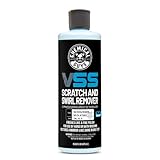How to Avoid Scratches on Your Car While Washing?
I’ve been washing my car for years, and let me tell you, there’s nothing worse than noticing a new scratch on your shiny paint after all that effort. It’s frustrating, right? You spend time scrubbing and rinsing, only to find swirl marks or tiny scratches ruining your car’s look. I’ve learned the hard way how to avoid scratches on a car while washing.
I’m sharing everything I know to help you keep your car’s paint flawless. Whether you’re a car enthusiast or just want to keep your daily driver looking good, these tips will save you from costly repairs and keep your ride sparkling.

Image by caranddriver
Washing your car seems simple, but doing it wrong can harm the paint. Scratches happen because of dirt, bad tools, or poor techniques. My goal is to guide you through the process so you can wash your car confidently without damaging it. Let’s dive into the details and make sure your car stays scratch-free.
Why Scratches Happen During Car Washing
Before we get into how to avoid scratches, let’s talk about why they happen. Understanding the cause makes it easier to prevent them. When I first started washing my car, I didn’t realize how much damage I was causing. Dirt and grime on the car’s surface act like sandpaper. If you rub a sponge or cloth over that dirt, it scratches the paint. Even tiny particles can leave marks.
Another culprit is using the wrong tools. I used to grab any old sponge from the kitchen, thinking it would do the job. Big mistake. Those sponges trap dirt and drag it across the paint. Cheap brushes or rough towels can also harm your car. And then there’s technique. Rushing through the wash or pressing too hard can create swirl marks—those annoying spiderweb-like scratches you see in sunlight.
Water quality matters too. Hard water with minerals can leave spots that are tough to remove without scratching. Over time, I’ve learned that every step of the washing process matters. Let’s break down how to do it right.
Pre-Wash Preparation: Setting the Stage for a Scratch-Free Wash
The key to avoiding scratches starts before you even touch the car. I can’t stress this enough—preparation is everything. Here’s what I do to get ready.
First, I park my car in a shaded area. Direct sunlight makes soap dry too fast, leaving spots that are hard to clean without scrubbing. Scrubbing equals scratches, so shade is your friend. Next, I gather all my supplies. Having everything ready means I’m not running around mid-wash, grabbing random tools that might not be safe.
Here’s a quick list of what I use:
| Item | Why It’s Important |
|---|---|
| Two buckets | One for soapy water, one for rinsing. Keeps dirt out of the soap. |
| Grit guards | Traps dirt at the bottom of the bucket so it doesn’t get back on your mitt. |
| Microfiber wash mitt | Soft and gentle on paint, traps dirt without dragging it. |
| Car-specific shampoo | Designed to lubricate and lift dirt safely. Avoid dish soap—it strips wax. |
| Soft microfiber towels | For drying without scratching. Avoid old rags or bath towels. |
| Hose with adjustable nozzle | Controls water flow for gentle rinsing. A pressure washer can be too harsh if misused. |
I always rinse the car first with a gentle stream of water. This loosens dirt, sand, and debris. If you skip this step, you’re rubbing that grit into the paint when you start washing. I also check my wash mitt and towels to make sure they’re clean. Even a little dirt stuck in the fibers can cause scratches.
Two-Bucket Wash Method: My Go-To Technique
I learned about the two-bucket wash method, and it’s been a game-changer. This technique keeps dirt away from your car’s surface, reducing the chance of scratches.
Here’s how it works. I fill one bucket with car shampoo mixed with water. The second bucket has plain water for rinsing. Each bucket has a grit guard at the bottom. The grit guard traps dirt so it doesn’t float back up.
I dip my microfiber mitt in the soapy water, wash a small section of the car, then rinse the mitt in the plain water bucket. I rub the mitt against the grit guard to release dirt. Then, I dip it back in the soapy water and move to the next section.
This method keeps the soap clean and free of grit. Before I used this technique, I’d dunk my sponge back into the same soapy water, picking up dirt and spreading it around.
No wonder my car had scratches! I wash from top to bottom because dirt tends to drip downward. I also work in small sections—like one door or half the hood—so the soap doesn’t dry on the surface.
Never press hard. Let the soap and mitt do the work. If a spot is stubborn, I soak it longer or use a dedicated bug and tar remover. Forcing it off with pressure is a sure way to scratch the paint.
Choosing the Right Tools and Products
I’ve already mentioned some tools, but let’s dive deeper into why they matter. Using the right products can make or break your wash. I learned this after ruining my car’s finish with a cheap sponge.
Microfiber wash mitts are my favorite. They’re soft, plush, and designed to trap dirt in their fibers. I have a few mitts so I can switch to a clean one if one gets too dirty. For wheels, I use a separate mitt because brake dust is abrasive and can scratch the body if you mix tools.
Car shampoo is another must. I use a pH-neutral shampoo that’s safe for wax and sealants. Dish soap might seem like a good idea because it cuts grease, but it strips protective coatings, leaving your paint vulnerable. I mix the shampoo according to the bottle’s instructions—too much soap can leave residue, and too little won’t lubricate enough.
For drying, I use microfiber towels or a blower. Old bath towels or chamois cloths can be rough and cause scratches. If I’m using towels, I pat the surface gently instead of wiping. A blower is even better because it avoids contact altogether.
Rinsing and Drying: The Final Steps to Avoid Scratches
Rinsing and drying are just as important as washing. I rinse thoroughly to remove all soap and dirt. Leftover soap can dry and leave spots that are hard to clean without scrubbing. I use a gentle stream from the hose, starting from the top and working down.
Drying is where many people mess up. I used to let my car air-dry, thinking it was fine. But water spots formed, especially in hard water areas, and removing them led to scratches. Now, I dry immediately after rinsing. If I’m using microfiber towels, I pat the surface to soak up water. Dragging the towel can pick up tiny particles and scratch the paint.
A blower is my preferred tool for drying. It’s touchless, so there’s no risk of scratches. If you don’t have one, stick with clean, soft microfiber towels. Make sure they’re free of tags or seams that could catch on the paint.
Dealing with Tough Spots Safely
Sometimes, your car has stubborn spots like bird droppings, tree sap, or tar. These can be tricky to remove without scratching. I’ve had my share of these messes, and here’s what I do.
For bird droppings, I act fast. The acid in droppings can etch the paint if left too long. I soak the spot with soapy water or a dedicated cleaner and let it sit for a minute. Then, I gently wipe it off with a microfiber mitt. Tree sap and tar need a specific remover. I apply the product, let it dissolve the gunk, and wipe it away softly.
Never use a scrub pad or abrasive tool. If the spot won’t come off, I reapply the cleaner and give it more time. Patience is key to avoiding scratches.
Protecting Your Car’s Paint After Washing
Washing is only half the battle. Protecting your car’s paint keeps it safe from future scratches. After every wash, I apply a quick detailer spray. It adds a layer of lubrication and enhances shine. Every few months, I wax or seal the car. Wax creates a barrier that makes dirt less likely to stick, so future washes are safer.
If you’re new to waxing, start with a spray wax. It’s easy to apply and works well. For longer protection, I use a paste wax or synthetic sealant. These products make your car’s surface slick, so dirt slides off more easily during washing.
Common Mistakes to Avoid
I’ve made plenty of mistakes over the years, and I want you to avoid them. Here are some common ones:
- Using one bucket: This mixes dirt back into the soap, causing scratches.
- Washing in direct sunlight: Soap dries too fast, leading to spots and scrubbing.
- Using household sponges or rags: They’re too abrasive for car paint.
- Skipping the pre-rinse: Rubbing dry dirt into the paint is a recipe for scratches.
- Air-drying the car: Water spots can form and require harsh cleaning to remove.
Learning from these mistakes has saved my car’s finish and made washing stress-free.
Maintaining Your Tools for Long-Term Success
Your tools need care too. After every wash, I clean my microfiber mitts and towels. I rinse them thoroughly and wash them in a washing machine with a gentle detergent. No fabric softener—it leaves residue that can transfer to the paint. I air-dry them to keep the fibers soft.
I also check my buckets and grit guards for dirt buildup. A quick rinse keeps them ready for the next wash. Storing tools properly prevents dust or debris from sticking to them. Clean tools mean a cleaner, scratch-free car.
Keep Your Car Scratch-Free with Care
Washing your car without scratches is all about preparation, technique, and the right tools. I’ve spent years perfecting my process, and now my car looks as good as the day I bought it. By using the two-bucket method, choosing microfiber tools, and protecting the paint, you can keep your car’s finish flawless.
It takes a little extra time, but the results are worth it. Imagine pulling up to work or a friend’s house with a car that shines without a single swirl mark. That’s the reward for doing it right.
FAQs
What’s the best way to wash a car without scratching it?
Use the two-bucket wash method with a microfiber mitt and car-specific shampoo. Pre-rinse the car, work in small sections, and dry gently with microfiber towels or a blower.
Can I use a regular towel to dry my car?
No, regular towels can be rough and cause scratches. Stick to microfiber towels or a blower for safe drying.
How do I should wax my car to protect it from scratches?
Wax every two to three months. A quick detailer spray after washing adds extra protection between waxing sessions.
Is a pressure washer safe for washing my car?
Yes, but use a wide-angle nozzle and keep the pressure low. Too much pressure can damage paint or seals.
What should I do if I notice a scratch after washing my car?
If it’s a light surface scratch, try a polish to buff it. For deeper scratches, consult a professional detailer to avoid making it worse.
Can dish soap be used to wash my car?
No, dish soap strips wax and can dry out rubber seals. Use a car-specific shampoo designed for safe cleaning.

David Peterson, the chief editor of sparepartscare. I am an automobile engineer and assign to an local firm with much experience in automobile equipment. During the time, most of my experience is related to the Industry of cars parts. I learned about the thing, when working with experienced inspectors, one must be as good as the inspector, or better, with knowledge of the project as well as the practical aspects of automobile industry.










